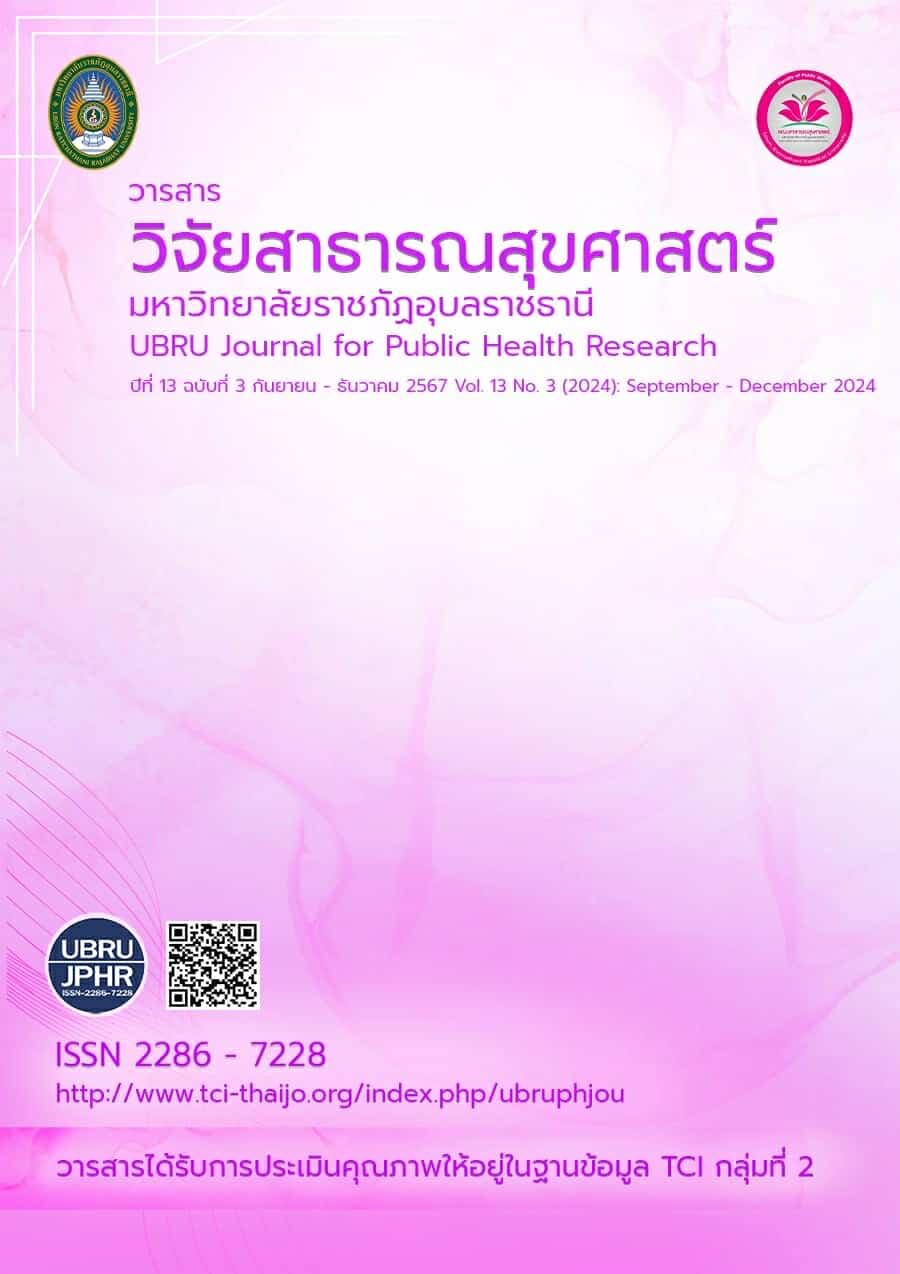รูปแบบการจัดการมูลฝอยโดยการมีส่วนร่วมของชุมชน ตำบลโคกเพชรพัฒนา อำเภอบำเหน็จณรงค์ จังหวัดชัยภูมิ
คำสำคัญ:
การมีส่วนร่วม, , การจัดการมูลฝอยในชุมชนบทคัดย่อ
การวิจัยครั้งนี้เป็นการวิจัยเชิงปฏิบัติการแบบมีส่วนร่วม มีวัตถุประสงค์เพื่อศึกษารูปแบบการจัดการมูลฝอยโดยการมีส่วนร่วมของชุมชน ตำบลโคกเพชรพัฒนา อำเภอบำเหน็จณรงค์ จังหวัดชัยภูมิ กลุ่มตัวอย่าง ประกอบด้วย 1) กลุ่มแกนนำองค์กร จำนวน 50 คน และ 2) กลุ่มเจ้าบ้านหรือตัวแทนครัวเรือน จำนวน 291 คน เก็บรวบรวมข้อมูลเชิงปริมาณโดยใช้แบบสอบถาม ข้อมูลเชิงคุณภาพโดยการสังเกต การสัมภาษณ์และการสนทนากลุ่ม ดำเนินการระหว่างเดือนตุลาคม 2566-มกราคม 2567 วิเคราะห์ข้อมูลเชิงปริมาณโดยใช้สถิติ ได้แก่ ความถี่ ร้อยละ ค่าเฉลี่ย ส่วนเบี่ยงเบนมาตรฐาน และสถิติที่เปรียบเทียบค่าเฉลี่ย (Paired t-test) และวิเคราะห์ข้อมูลเชิงคุณภาพด้วยการวิเคราะห์เชิงเนื้อหา (Content analysis)
ผลการวิจัย พบว่า ตำบลโคกเพชรพัฒนามีปัญหาหลักด้านการจัดการมูลฝอย ประชาชนขาดการคัดแยกมูลฝอยและนำมูลฝอยมาใช้ประโยชน์น้อย ส่วนใหญ่จัดการมูลฝอยโดยการเทกองและเผากลางแจ้ง มีแนวโน้มเกิดการลักลอบทิ้งมูลฝอยเพิ่มขึ้น ความรู้เกี่ยวกับการจัดการมูลฝอยในชุมชนอยู่ในระดับต่ำ ร้อยละ 56.0 (Mean=6.5, S.D.=1.3) การปฏิบัติในการจัดการมูลฝอยอยู่ในระดับปานกลาง ร้อยละ 60.8 (Mean=2.30, S.D.=0.55) การมีส่วนร่วมในการจัดการมูลฝอยของประชาชนอยู่ในระดับ
ปานกลาง (Mean=3.12, S.D.=0.40) ผลจากการสนทนากลุ่มอย่างมีส่วนร่วมจากภาคีเครือข่ายเกิดแผนปฏิบัติการ “โครงการพัฒนาศักยภาพด้านการจัดการมูลฝอย ตำบลโคกเพชรพัฒนา” ภายหลังดำเนินกิจกรรม พบว่า ความรู้เกี่ยวกับการจัดการมูลฝอยอยู่ในระดับสูง (Mean=8.4, S.D.=1.16) การปฏิบัติในการจัดการมูลฝอยอยู่ในระดับดี (Mean=2.6, S.D.=0.16) การมีส่วนร่วมในการจัดการมูลฝอยของประชาชนอยู่ในระดับมาก (Mean=3.83, S.D.=0.64) ค่าเฉลี่ยเพิ่มขึ้นอย่างมีนัยสำคัญทางสถิติ
(p<0.001) ทั้งนี้ประชาชนมีการคัดแยกมูลฝอยครัวเรือนด้วยการจัดทำถังขยะเปียก เกิดการแปรรูปมูลฝอยเป็นผลิตภัณฑ์ในชุมชน ได้แก่ น้ำหมักชีวภาพ กระถางปลูกผักจากยางรถยนต์ หลุมน้ำธนาคารใต้ดินจากขวดพลาสติก ชุมชนสะอาด และสามารถลดปริมาณมูลฝอยตามที่ทางสาธารณะจากการลักลอบทิ้งมูลฝอย
ปัจจัยแห่งความสำเร็จ คือ 1) ภาคท้องถิ่น ผู้นำท้องถิ่นมีวิสัยทัศน์เล็งเห็นความสำคัญในการจัดการมูลฝอย พร้อมเป็น
แรงสนับสนุนในด้านงบประมาณ บุคลากร วัสดุอุปกรณ์ รวมถึงเป็นกลไกตัวกลางที่เชื่อมประสานระหว่างภาคีเครือข่ายและชุมชน
2) ภาควิชาการ มีการกระตุ้นส่งเสริมองค์ความรู้ด้านการจัดการมูลฝอยอย่างต่อเนื่องหลากหลายวิธี ทำให้ประชาชนเข้าถึงข้อมูลที่ถูกต้องและเกิดแรงจูงใจในการปฏิบัติ และ 3) ภาคประชาชน จากการมีส่วนร่วมในการจัดการมูลฝอยของแกนนำชุมชนและประชาชน ถือเป็นหัวใจหลักของการดำเนินงาน โดยให้เข้ามามีส่วนร่วมตั้งแต่การวางแผน ร่วมคิดตัดสินใจ ร่วมดำเนินการ รวมถึงร่วมติดตามประเมินผล นำไปสู่ผลสำเร็จของรูปแบบการจัดการมูลฝอยโดยการมีส่วนร่วมของชุมชนอย่างแท้จริง
เอกสารอ้างอิง
กลุ่มงานยุทธศาสตร์และข้อมูลเพื่อการพัฒนาจังหวัด สำนักงานจังหวัดชัยภูมิ. (2565). จังหวัดชัยภูมิ. สืบค้นเมื่อวันที่ 18 เมษายน 2566, จาก https://www.chaiyaphum.go.th/page_about/about6.php.
กรมควบคุมมลพิษ. (2566). รายงานสถานการณ์สถานที่กำจัดขยะมูลฝอยของประเทศไทย ปี พ.ศ. 2566. กรุงเทพมหานคร: กระทรวงทรัพยากรธรรมชาติและสิ่งแวดล้อม.
ปวีณา ปาทาน. (2564). รูปแบบการจัดการมูลฝอยโดยการมีส่วนร่วมของชุมชนหนองม่วง เทศบาลเมืองศรีสะเกษ จังหวัดศรีสะเกษ. วิทยานิพนธ์ปริญญาสาธารณสุขศาสตรมหาบัณฑิต มหาวิทยาลัยมหาสารคาม.
วราวุฒิ มหามิตร. (2563). รูปแบบการจัดการขยะมูลฝอยครัวเรือนโดยการมีส่วนร่วมของชุมชน กรณีศึกษาตำบลละหาน อำเภอจัตุรัส จังหวัดชัยภูมิ. วิทยานิพนธ์ปริญญาสาธารณสุขศาสตรดุษฎีบัณฑิต สาขาวิชาสาธารณสุขศาสตร์ มหาวิทยาลัยนเรศวร.
วิชาญ ดำรงกิจ. (2566). การพัฒนารูปแบบการจัดการมูลฝอยในชุมชนแบบมีส่วนร่วมของชุมชน กรณีศึกษาหมู่ 8 องค์การบริหารส่วนตำบลหนองนาก อำเภอหนองแค จังหวัดสระบุรี. Journal of Modern Learning Development., 8 (6), 201-212.
วิทกานต์ สารแสน และคณะ. (2561). การพัฒนารูปแบบการจัดการมูลฝอยชุมชนบ้านหวาย ตำบลนาสีนวน อำเภอกันทรวิชัย จังหวัดมหาสารคาม. วารสารมนุษยศาสตร์และสังคมศาสตร์ บัณฑิตวิทยาลัย มหาวิทยาลัยราชภัฏพิบูลสงคราม ., 12 (2), 564-580.
สุภาพร แปยอ. (2567). การพัฒนารูปแบบการจัดการขยะมูลฝอยอย่างมีส่วนร่วมของชุมชน กรณีศึกษาชุมชนตำบลเหล่าบก อำเภอม่วงสามสิบ จังหวัดอุบลราชธานี. วารสารวิชาการสาธารณสุขชุมชน, 10(2), 110-124.
สำนักงานส่งเสริมการปกครองท้องถิ่นจังหวัดชัยภูมิ. (2566). แผนปฏิบัติการจัดการขยะมูลฝอยชุมชน “จังหวัดสะอาด” จังหวัดชัยภูมิ พ.ศ. 2566. จังหวัดชัยภูมิ.
อภิชาติ ตั้งปรัชญากูล. (2560). การพัฒนารูปแบบการจัดการขยะมูลฝอยอย่างครบวงจรแบบมีส่วนร่วมของชุมชนในเขตเทศบาลตำบล จังหวัดกาฬสินธุ์. วิทยานิพนธ์ปริญญาปรัชญาดุษฎีบัณฑิต มหาวิทยาลัยราชภัฏวไลยอลงกรณ์.
องค์การบริหารส่วนตำบลโคกเพชรพัฒนา. (2566). ผลการสำรวจชุมชนด้านการจัดการมูลฝอยในตำบลโคกเพชรพัฒนา. ชัยภูมิ: องค์การบริหารส่วนตำบลโคกเพชรพัฒนา.
Cohen, J. M., & Uphoff, N. T. (1981). Rural Development Participation: Concept and Measures for Project Design Implementation and Evaluation. Ithaca, NY: Rural Development Committee Center for International Studies, Cornell University.
Kemmis, S., & McTaggart, R. (1988). The Action Research Planner. 3rd ed. Geelong, Australia: Deakin University Press.
ดาวน์โหลด
เผยแพร่แล้ว
รูปแบบการอ้างอิง
ฉบับ
ประเภทบทความ
สัญญาอนุญาต
ลิขสิทธิ์ (c) 2024 คณะสาธารณสุขศาสตร์ มหาวิทยาลัยราชภัฏอุบลราชธานี

อนุญาตภายใต้เงื่อนไข Creative Commons Attribution-NonCommercial-NoDerivatives 4.0 International License.
เนื้อหาและข้อมูลในบทความที่ลงตีพิมพ์ในวารสารวารสารวิจัยสาธารณสุขศาสตร์ มหาวิทยาลัยราชภัฏอุบลราชธานี ถือเป็นข้อคิดเห็นและความรับผิดชอบของผู้เขียนบทความโดยตรงซึ่งกองบรรณาธิการวารสาร ไม่จำเป็นต้องเห็นด้วย หรือร่วมรับผิดชอบใดๆ
บทความ ข้อมูล เนื้อหา รูปภาพ ฯลฯ ที่ได้รับการตีพิมพ์ในวารสารนี้ ถือเป็นลิขสิทธิ์ของวารสารฯ หากบุคคลหรือหน่วยงานใดต้องการนำทั้งหมดหรือส่วนหนึ่งส่วนใดไปเผยแพร่ต่อหรือเพื่อกระทำการใดๆ จะต้องได้รับอนุญาตเป็นลายลักอักษรณ์จากบรรณาธิการวารสารนี้ก่อนเท่านั้น


